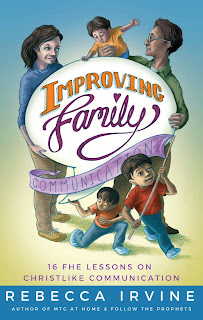In an era when social media and smart phones are slowly decreasing face-to-face communication and as unproductive communication practices seem to be spreading, Improving Family Communication: 16 FHE Lessons on Christlike Communication by Rebecca Irvine promises busy LDS parents easy plans for how to teach their children healthy communication skills.
The lessons start from a foundation of self-concept and self-worth, lead into emotions, non-verbal communication, then various methods of communicating with civility. Then they also cover topics necessary for repairing relationships after conflict, such as apologies and forgiveness.
Each lesson has a purpose, a scripture, a thought, a short lesson, discussion questions, a fun activity to reinforce the lesson, a fun activity for much smaller children, a challenge to act on, and suggested music from the hymn book or primary song book to sing.
Reading through, I felt like the lesson information was tightly focused and helpful, without getting technical or jargon-ish. The activities seemed both fun and effective for reinforcing the lesson purpose. The kid in me wishes I could be part of these activities.
Growing up, I personally learned about communication through a lot of different experiences in my life and different books, but I think if I had had these concepts presented to me in an organized way like this, it would have helped me a lot in life. I think this is a great thing to be made available to LDS parents.
A quick survey of Amazon’s books seems to show that this is the only one of its kind that is aimed at helping parents train their kids in communication. I saw lots of books dedicated to helping adults talk to adults and adults talk to kids, but none that seemed geared toward lessons for kids to teach them foundational principles and good communication practices.
Is there anything not to like about this book?
Wellllll…I personally found myself wanting more depth in the lesson sections (‘cause I’m curious like that), but I realize this book wasn’t meant to be an elaborate treatise, so it is just what it should be.
Disclosure: I was given a free copy for reviewing purposes, but this in no way influences my review.
Continue reading at the original source →




